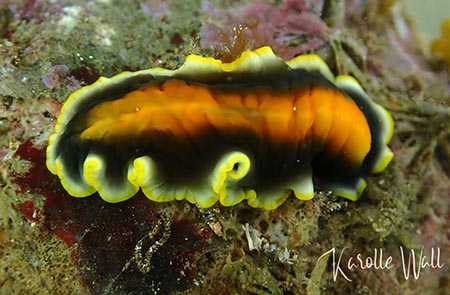|
Pseudoceros
paralaticlavus Newman & Cannon 1994 ID from Newman &
Cannon CD, where the top photo, taken by Scott Johnson in Hawai`i, is
included. In
1995 I sent the specimen illustrated at center to Leslie Newman, who
identified it as P. paralaticlavus. Note that Jebb's Flatworm (Pseudoceros jebborum) has a very similar color pattern. Separating the two species visually can be difficult. An entire web page is devoted to this topic. Cory Pittman suggests that the central pale band in both species may be facultatively covered by caramel-colored mucus, and that this color, often associated with jebborum, is probably not a good character for separating the two. He offers the following tentative clarification: in paralaticlavus the central band is narrow, about 1/4 to 1/3 the worm's width, measured when it is crawling. In jebborum the central band is wider, about 1/2 to 3/4 of the worm's width, measured when it is crawling. **see below Size might be another
character: according to Newman & Cannon jebborum grows longer
than paralaticlavus: 2.75 in. (70 mm) vs. 2 in. (50 mm) respectively. Pseudoceros paralaticlavus
is known from Reunion Island in the Western Indian Ocean to Hawai`i
in the Central Pacific. More photos of Pseudoceros paralaticlavus from Hawaii, some with pigmented central bands, can be seen on Keoki Stender's website. cf.
Euryleptid 3 is quite similar and could be confused with this species. |
 Newman & Cannon include this photo on their CD as Pseudoceros paralaticlavus. |
 Specimen sent to Leslie Newman in 1995, identified as Pseudoceros paralaticlavus. |
 pigmented specimen Dee Westcott, Kona, Hawai'i |
 pigmented specimen Cory Pittman, Maui |
 |
|
pigmented
specimen
Pseudoceros
jebborum: "Central band 1/2 to 3/4 animal's width when
crawling; pigment, when present, confined to central band and medium
orange-brown in hue; pigmented mucus lost in longitudinal strips; continuous
marginal yellow line present; lighter line in middle of central band
seldom present." |
hawaiisfishes.com